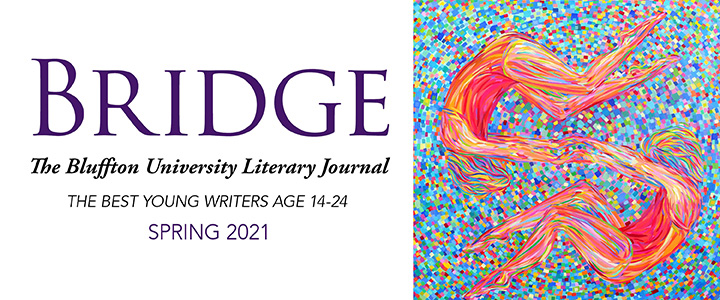Bridge: Spring 2021
A Letter from the Editor
Among the massive disruptions of 2020, finding ways to carry on with some semblance of our old lives and work has been a necessary challenge. At Bluffton, this meant a half-semester of online classes in spring 2020, and resuming mostly live, in-person coursework in the fall under special protocols that enabled us to keep the campus open and humming, if somewhat muffled by masks and social distancing. Amid the departure of Bridge editor Melissa Michal Slocum, budget pressures, the shift to an all-online format, and an already hectic schedule for fall 2020, I agreed to edit the journal. With a dedicated student staff, a great deal of team-oriented labor, and much support from the Bluffton public relations department, we released the Fall 2020 issue on schedule, chose material for another, and now offer what may be our most diverse, wide-ranging, and scintillating gathering of work by young writers yet.
Readers will not find a pandemic-themed issue here—surely the pandemic has received plenty of attention. Yet these young writers and artists are deeply engaged—both with timeless themes and with their contemporary iterations and manifestations. So Nora Mohamed’s drama “Six Fifty-Six” brilliantly engages both depression and climate change, and poets Abbie Hart, Liam Strong, Charlie Neer, Aimee Lowenstern, and many others explore the turns and twists of love and desire in contexts that challenge and sometimes explode tidy, traditional romantic narratives—even as they reaffirm that the need for connection and meaning will not be denied. The temporal and stylistic range is wide as well: Remi Seamon harks back to Van Gogh, Courtney Moody offers a partly whimsical, partly disquieting recipe for communal production of peanut butter pies, and Shawn Anto laments his native India’s loss of coastline: “I forgot / where home was.”
The fiction that caught our editorial eyes meshed stylistic fluency with deep human insight, and sometimes with innovative forms as well. Michaela Crawford’s “Dye/Die” has its roots in horror, as Mac Bowers’ “Pricker Bushes” does in magical realism. Others work just as cannily in more realistic modes: Jonah Bradenday’s “The Vogelkop” draws symbolic strength from the titular bird’s mating practices, Alexa Bocek’s “Swedish Death” turns on the challenges of a young woman sorting her dead mother’s possessions, and Jacob C. Connerly’s “Stoma” offers a surprise ending worthy of O. Henry. Jessica Baker’s essay “and I ate and I eight” sensitively examines issues of body image and the intimate, often damaging ways that girls and women judge and influence each other.
Art submissions for this issue included a wealth of strong work from South Korea, from which we chose work by Hyewon Cho, Hyeseon Kim, and Rayoung (Madeline) Kim, each of whom attends a different Seoul high school. Their work, and the other art readers will encounter, reflects their technical proficiency, the common themes suggested by titles like “Reflection of Humanity,” “Nostalgia,” and “Escape,” and the startling, revelatory innovations they bring to such themes.
And readers will surely want to contemplate Van Lanigh's enigmatically lovely “Twins,” chosen by staff as our cover image. Its figures float in a space that seems womb-like yet brilliantly illuminated, stretching toward each other yet forever separate. Are they moving toward each other, or away? The same question, of course, might be asked about us all.
Jeff Gundy, Editor
Bridge: The Bluffton University Literary Journal
